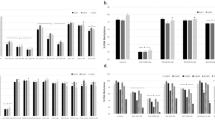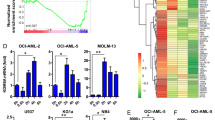Abstract
Phosphoinositide-phospholipase C (PI-PLC) beta1 can be considered a specific target for demethylating therapy in high-risk myelodysplastic syndrome (MDS) patients, as azacitidine treatment has been associated with a PI-PLCbeta1-specific promoter demethylation, and induction of PI-PLCbeta1 gene and protein expression. However, little is known about the molecular effect of azacitidine in low-risk MDS or the functional mechanisms linked with azacitidine effect on PI-PLCbeta1 promoter. In the present study, we further investigated the role of epigenetic regulation of PI-PLCbeta1, mainly focusing on the structure of the PI-PLCbeta1 promoter. We first examined the effect of azacitidine on PI-PLCbeta1 promoter methylation and gene expression in low-risk MDS. Moreover, we studied the expression of key molecules associated with the nuclear inositide signaling pathways, such as cyclin D3. By applying a chromatin immunoprecipitation method, we also studied the correlation between the demethylating effect of azacitidine and the degree of recruitment to PI-PLCbeta1 promoter of some transcription factors implicated in hematopoietic stem cell proliferation and differentiation, as well as of the methyl-CpG-binding domain proteins, which specifically interact with methylated DNA. Taken together, our results hint at a specific involvement of PI-PLCbeta1 in epigenetic mechanisms, and are particularly consistent with the hypothesis of a role for PI-PLCbeta1 in azacitidine-induced myeloid differentiation.
This is a preview of subscription content, access via your institution
Access options
Subscribe to this journal
Receive 12 print issues and online access
$259.00 per year
only $21.58 per issue
Buy this article
- Purchase on Springer Link
- Instant access to full article PDF
Prices may be subject to local taxes which are calculated during checkout





Similar content being viewed by others
References
Wymann MP, Schneiter R . Lipid signalling in disease. Nat Rev Mol Cell Biol 2008; 9: 162–176.
Perl AE, Carroll M . Exploiting signal transduction pathways in acute myelogenous leukemia. Curr Treat Options Oncol 2007; 8: 265–276.
Ramazzotti G, Faenza I, Fiume R, Matteucci A, Piazzi M, Follo MY et al. The physiology and pathology of inositide signaling in the nucleus. J Cell Physiol 2011; 226: 14–20.
Follo MY, Mongiorgi S, Finelli C, Clissa C, Ramazzotti G, Fiume R et al. Nuclear inositide signaling in myelodysplastic syndromes. J Cell Biochem 2010; 109: 1065–1071.
Faenza I, Bregoli L, Ramazzotti G, Gaboardi G, Follo MY, Mongiorgi S et al. Nuclear phospholipase C beta1 and cellular differentiation. Front Biosci 2008; 13: 2452–2463.
Faenza I, Ramazzotti G, Bavelloni A, Fiume R, Gaboardi GC, Follo MY et al. Inositide-dependent phospholipase C signaling mimics insulin in skeletal muscle differentiation by affecting specific regions of the cyclin D3 promoter. Endocrinology 2007; 148: 1108–1117.
Griner EM, Kazanietz MG . Protein kinase C and other diacylglycerol effectors in cancer. Nat Rev Cancer 2007; 7: 281–294.
Cooper AB, Sawai CM, Sicinska E, Powers SE, Sicinski P, Clark MR et al. A unique function for cyclin D3 in early B cell development. Nat Immunol 2006; 7: 489–497.
Furukawa Y . Cell cycle control genes and hematopoietic cell differentiation. Leuk Lymphoma 2002; 43: 225–231.
Issa JP . Epigenetic changes in the myelodysplastic syndrome. Hematol Oncol Clin North Am 2010; 24: 317–330.
Nolte F, Hofmann WK . Molecular mechanisms involved in the progression of myelodysplastic syndrome. Future Oncol 2010; 6: 445–455.
Garcia-Manero G, Fenaux P . Hypomethylating agents and other novel strategies in myelodysplastic syndromes. J Clin Oncol 2011; 29: 516–523.
Fenaux P, Mufti GJ, Hellstrom-Lindberg E, Santini V, Finelli C, Giagounidis A et al. Efficacy of azacitidine compared with that of conventional care regimens in the treatment of higher-risk myelodysplastic syndromes: a randomised, open-label, phase III study. Lancet Oncol 2009; 10: 223–232.
Musto P, Maurillo L, Spagnoli A, Gozzini A, Rivellini F, Lunghi M et al. Azacitidine for the treatment of lower risk myelodysplastic syndromes: a retrospective study of 74 patients enrolled in an Italian named patient program. Cancer 2010; 116: 1485–1494.
Silverman LR, Demakos EP, Peterson BL, Kornblith AB, Holland JC, Odchimar-Reissig R et al. Randomized controlled trial of azacitidine in patients with the myelodysplastic syndrome: a study of the cancer and leukemia group B. J Clin Oncol 2002; 20: 2429–2440.
Taby R, Issa JP . Cancer epigenetics. CA Cancer J Clin 2010; 60: 376–392.
Lopez J, Percharde M, Coley HM, Webb A, Crook T . The context and potential of epigenetics in oncology. Br J Cancer 2009; 100: 571–577.
Quintas-Cardama A, Santos FP, Garcia-Manero G . Therapy with azanucleosides for myelodysplastic syndromes. Nat Rev Clin Oncol 2010; 7: 433–444.
Follo MY, Mongiorgi S, Bosi C, Cappellini A, Finelli C, Chiarini F et al. The Akt/mammalian target of rapamycin signal transduction pathway is activated in high-risk myelodysplastic syndromes and influences cell survival and proliferation. Cancer Res 2007; 67: 4287–4294.
Follo MY, Finelli C, Bosi C, Martinelli G, Mongiorgi S, Baccarani M et al. PI-PLCbeta-1 and activated Akt levels are linked to azacitidine responsiveness in high-risk myelodysplastic syndromes. Leukemia 2008; 22: 198–200.
Follo MY, Finelli C, Clissa C, Mongiorgi S, Bosi C, Martinelli G et al. Phosphoinositide-phospholipase C beta1 mono-allelic deletion is associated with myelodysplastic syndromes evolution into acute myeloid leukemia. J Clin Oncol 2009; 27: 782–790.
Follo MY, Finelli C, Mongiorgi S, Clissa C, Bosi C, Testoni N et al. Reduction of phosphoinositide-phospholipase C beta1 methylation predicts the responsiveness to azacitidine in high-risk MDS. Proc Natl Acad Sci USA 2009; 106: 16811–16816.
Follo MY, Finelli C, Mongiorgi S, Clissa C, Chiarini F, Ramazzotti G et al. Synergistic induction of PI-PLCbeta1 signaling by azacitidine and valproic acid in high-risk myelodysplastic syndromes. Leukemia 2011; 25: 271–280.
Vardiman JW, Harris NL, Brunning RD . The World Health Organization (WHO) classification of the myeloid neoplasms. Blood 2002; 100: 2292–2302.
Vardiman JW, Thiele J, Arber DA, Brunning RD, Borowitz MJ, Porwit A et al. The 2008 revision of the World Health Organization (WHO) classification of myeloid neoplasms and acute leukemia: rationale and important changes. Blood 2009; 114: 937–951.
Greenberg P, Cox C, LeBeau MM, Fenaux P, Morel P, Sanz G et al. International scoring system for evaluating prognosis in myelodysplastic syndromes. Blood 1997; 89: 2079–2088.
Filì C, Gobbi M, Martinelli G, Finelli C, Iacobucci I, Ottaviani E et al. 5-Azacitidine five days/monthly schedule in symptomatic low-risk (IPSS:0-1) myelodysplastic (MDS) patients. Clin Biol Eff Haematol 2010; 95 (Suppl 2): 556.
Filì C, Gobbi M, Martinelli G, Finelli C, Iacobucci I, Ottaviani E et al. Azacitidine low-dose schedule in symptomatic low-risk (IPSS:0-1) myelodysplastic patients. Clin Biol Eff Haematol 2010; 95 (Suppl 3): S32–S33.
Fili C, Finelli C, Gobbi M, Martinelli G, Iacobucci I, Ottaviani E et al. Azacitidine low-dose schedule in low-risk myelodysplastic syndromes. Preliminary results of a multicenter phase II study. ASH Ann Meeting Abstracts 2010; 116: 4029.
Fil C, Finelli C, Gobbi M, Martinelli G, Iacobucci I, Ottaviani E et al. Azacitidine low-dose schedule in low-risk myelodysplastic syndromes. Clinical results of a multicenter phase II study. Leuk Res 2011; 35 (Suppl 1): S84–S85.
Cheson BD, Greenberg PL, Bennett JM, Lowenberg B, Wijermans PW, Nimer SD et al. Clinical application and proposal for modification of the International Working Group (IWG) response criteria in myelodysplasia. Blood 2006; 108: 419–425.
Wingender E, Chen X, Hehl R, Karas H, Liebich I, Matys V et al. TRANSFAC: an integrated system for gene expression regulation. Nucleic Acids Res 2000; 28: 316–319.
Quandt K, Frech K, Karas H, Wingender E, Werner T . MatInd and MatInspector: new fast and versatile tools for detection of consensus matches in nucleotide sequence data. Nucleic Acids Res 1995; 23: 4878–4884.
Lidonnici MR, Corradini F, Waldron T, Bender TP, Calabretta B . Requirement of c-Myb for p210(BCR/ABL)-dependent transformation of hematopoietic progenitors and leukemogenesis. Blood 2008; 111: 4771–4779.
Morris JF, Rauscher 3rd FJ, Davis B, Klemsz M, Xu D, Tenen D et al. The myeloid zinc finger gene, MZF-1, regulates the CD34 promoter in vitro. Blood 1995; 86: 3640–3647.
Ballestar E, Esteller M . Methyl-CpG-binding proteins in cancer: blaming the DNA methylation messenger. Biochem Cell Biol 2005; 83: 374–384.
Bogdanovic O, Veenstra GJ . DNA methylation and methyl-CpG binding proteins: developmental requirements and function. Chromosoma 2009; 118: 549–565.
Klose RJ, Bird AP . Genomic DNA methylation: the mark and its mediators. Trends Biochem Sci 2006; 31: 89–97.
Acknowledgements
This work was supported by Italian PRIN-Cofin, Italian MIUR-FIRB and Celgene Corporation. We would also thank Dr Emanuela Ottaviani and Dr Mariana Stoyanova from the Department of Hematology and Medical Oncology “L e A Seràgnoli” of the University of Bologna; Dr Anna Candoni and Dr Erika Simeone from the Division of Hematology of the University of Udine; Professor Franco Lauria and Dr Monica Bocchia from the Department of Hematology of the University of Siena; and Dr Maurizio Miglino from the Chair of Hematology of the University of Genova, Italy, for providing biological samples and clinical data.
Author information
Authors and Affiliations
Corresponding author
Ethics declarations
Competing interests
The authors declare no conflict of interest.
Additional information
Supplementary Information accompanies the paper on the Leukemia website
Rights and permissions
About this article
Cite this article
Follo, M., Russo, D., Finelli, C. et al. Epigenetic regulation of nuclear PI-PLCbeta1 signaling pathway in low-risk MDS patients during azacitidine treatment. Leukemia 26, 943–950 (2012). https://doi.org/10.1038/leu.2011.300
Received:
Revised:
Accepted:
Published:
Issue Date:
DOI: https://doi.org/10.1038/leu.2011.300
Keywords
This article is cited by
-
A miRNA screening identifies miR-192-5p as associated with response to azacitidine and lenalidomide therapy in myelodysplastic syndromes
Clinical Epigenetics (2023)
-
Response of high-risk MDS to azacitidine and lenalidomide is impacted by baseline and acquired mutations in a cluster of three inositide-specific genes
Leukemia (2019)
-
Predictors of clinical responses to hypomethylating agents in acute myeloid leukemia or myelodysplastic syndromes
Annals of Hematology (2018)



